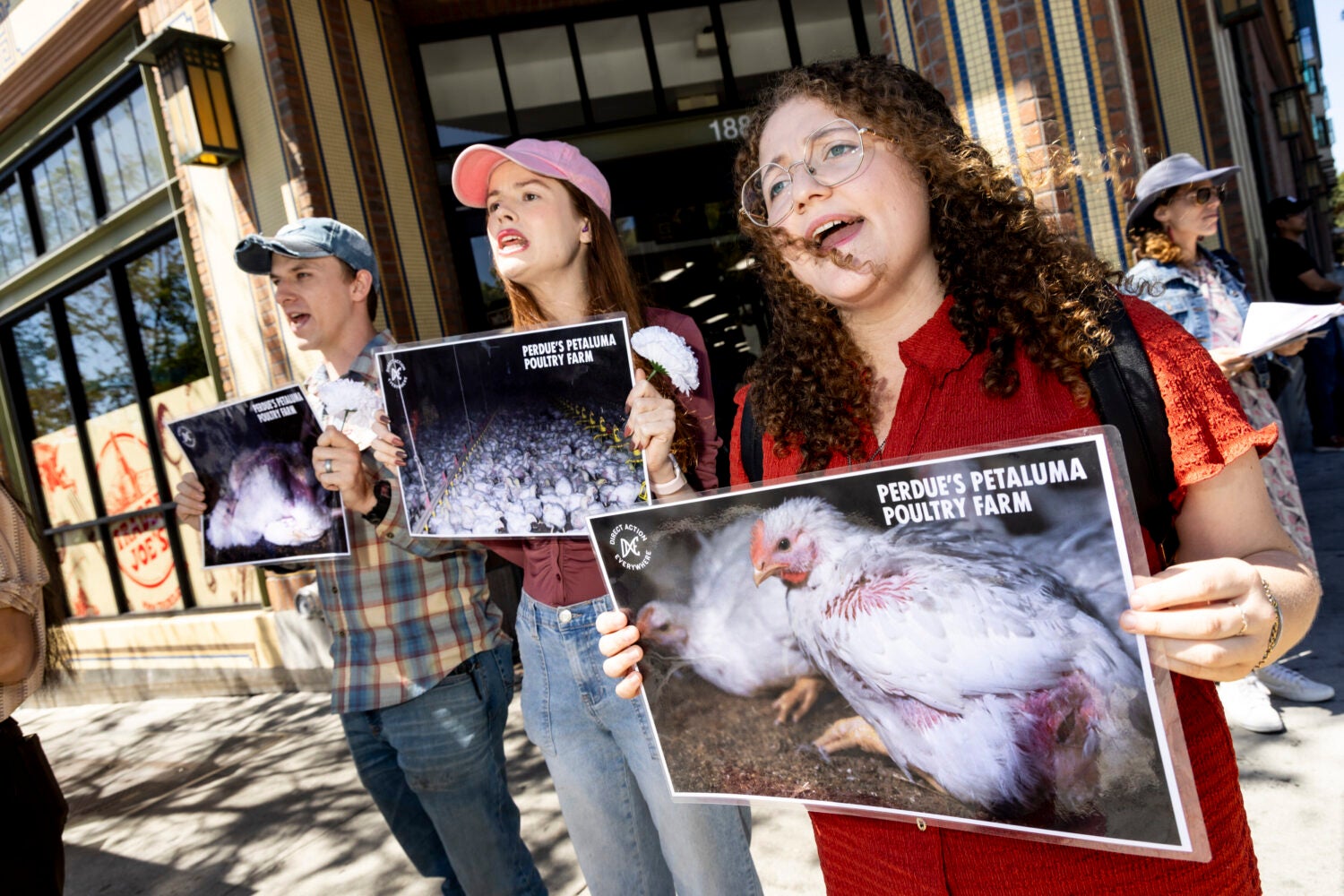An advocate breaks into a California livestock farm — which he knows has violated animal cruelty laws violations — and ferries away 70 mortally ill ducks. The birds receive fast medical attention, and all except one survive. But for his deed, the man is tried and convicted of trespassing.
If he had walked onto the property to save a human being’s life, he likely could have claimed California’s necessity defense, a law intended to shield Good Samaritans from punishment for lower-level offenses committed when someone’s life is in danger.
The same standard should apply to people who save the life of an animal, argues Kristen A. Stilt, a professor of law at Harvard and faculty director of the Animal Law & Policy Program.
“The law in California requires that the defendant act in an emergency to prevent significant bodily harm or evil to himself or herself or ‘someone else,’” she says. “It doesn’t say that it has to be another human.”
In a pair of ongoing criminal cases in California — one at the trial court level and one on appeal — animal rights activists removed sick or dying animals from farms in Sonoma County and are now facing jail time or stiff fines for their actions. Stilt, who submitted a friend of the court brief for the person whose case is on appeal, says that in both situations, the defendants should have been allowed to raise the necessity defense, which may potentially excuse the break-ins because they prevented a greater harm — the animals’ deaths.
Such a finding would be in line with other policies in the Golden State that acknowledge and account for the pain and suffering of animals, Stilt argues. And allowing advocates to raise the necessity defense doesn’t mean they would automatically win their cases, she says, adding that defendants would still have to show that the animals were, in fact, in immediate danger and that there was no other reasonable option to save them.
“We’re arguing, yes, the defendants will still have to prove all those elements, but they shouldn’t be precluded as a matter of law from trying,” she explains.
In an interview with Harvard Law Today, Stilt explains how the necessity defense works, why she believes it should also apply to the rescue of animals — and what it would mean for California to take this step for animal welfare.

Harvard Law Today: What is the “necessity defense,” and how does it work in California?
Kristen Stilt: The necessity defense essentially excuses an offense because averting a greater harm justifies committing this lesser harm. Typically, we are talking about averting a harm to a person, but I’m arguing that the language in California law does not specify that it must be imminent harm to a human. Often, the crime being excused is a property-based one, such as trespass, which is what we’re talking about in these current cases.
Now, just because a defendant can put forth this defense doesn’t mean they will be successful. There are several elements to this defense, including that the action didn’t create a danger greater than the one avoided, that the actor believed the act was necessary, that a reasonable person would have believed it was necessary, etc. What we’re arguing is that yes, the defendants will still have to prove all those elements, but they shouldn’t be precluded as a matter of law from trying, just because the “someone” they rescued is an animal and not a human.
HLT: Why do you argue that the defense should apply to the rescue of animals as well as people?
Stilt: Because neither the statute nor case law nor the jury instructions specify that the harm has to be to a human being. The instructions require that the defendant acted in an emergency to prevent a significant bodily harm or evil to himself or herself or “someone else.” It doesn’t say that it has to be another human. When we think about who can experience significant bodily harm — it’s a being who is sentient and can experience pain. There is no reason why that couldn’t be a dog or a horse or a pig, in addition to a human being.
HLT: You also argue that other California laws point to a policy of protecting animals. Can you tell me more about that?
Stilt: California has many laws that indicate that animals are sentient beings whose harm is something we want to avoid. There are laws criminalizing animal cruelty and there are laws protecting animals from bodily harm.
Perhaps one of the clearest examples is the state’s vehicle confinement law. A similar law exists in other states. The basic idea is that if you see a dog (or other animal) closed up in a car on a hot day and you see that dog panting — as temperatures rise, dogs pant because they cannot sweat — and you reasonably believe the dog is going to die or suffer severe bodily injury, you can break into the car to get the dog out. This operates differently than the necessity defense, because it’s more like an immunity from prosecution. But it’s telling that the state of California changed the law from only allowing first responders to do this, to allowing anyone to do it, because too many animals were dying in hot cars and they needed to reassure the public, to encourage the public, to act. It’s an important indicator that state lawmakers believe that an animal’s life is more important than property damage in certain circumstances.
As you can see, the public policy of the state of California shows very clearly that avoiding harm to animals is something that is to be desired, and that bolsters the interpretation that preventing harm to an animal would meet that portion of the necessity defense.
HLT: If the defense were applied to those rescuing animals, would the animals have to be seriously sick or dying, or could it apply more broadly to any farm animals? Where do we draw the line?
Stilt: It would only apply in an emergency situation. That’s the nature of necessity — you have no other option, and you believe the act is necessary under the circumstances to prevent imminent harm or death.
HLT: A prosecutor might not want the defendant to be able to claim the necessity defense for strategic reasons. Are there other reasons to try to keep this defense out?
Stilt: In these California cases, they’re notably not charging the defendants with theft. There’s a reason why. In previous cases in Utah, they charged the animal activists with theft, and the definition of theft was something that exceeded the value of, say, $20. That brought into evidence questions like, “what is the value of a dying piglet?” Defendants were arguing that it must not have been much, given the conditions the pigs were living in — evidence that they were then allowed to bring into court. The corporation involved did not like that whatsoever, nor did the prosecutor, because the jury saw how terrible the conditions were in the facility.
Perhaps to avoid that situation, prosecutors in these California cases didn’t charge the defendants with theft — only trespassing. But if the necessity defense were to be allowed, the defendants would be able to present evidence that, again, the corporate victim may not want the jury to see. Why were these situations an emergency? Because of the conditions that exist there. Why did the defendants think they had no other alternative but to act? Because they have previously entered these facilities, filmed what is going on, and notified the authorities of what was happening — and no one did anything.
HLT: What were the conditions like on the farms at issue in these two cases?
Stilt: The Sonoma County farmers are very upset about these cases. They claim to have some of the best conditions in the country, and that may be true — but they are still not good. The advocates seemed to strongly believe that on any given day, they would find a dying animal that would be dead within hours if he or she did not receive emergency treatment. That’s a well-founded belief of a situation that is common in these mass industrial agriculture businesses. Animals are there to make a profit, and profit determines whether they are worth saving. From the undercover investigations I’ve seen, there will always be dying animals in these facilities. We’re not talking about a backyard farmer — we’re talking about huge industrial settings, where the loss of some animals is just part of doing business.
HLT: Are there other states or countries that allow something like the necessity defense to apply to the rescue of animals? Or would California be a leader on this issue if it does so?
Stilt: California would likely be at the forefront, but there are a few similar situations we can look at in other places. In Wisconsin, there was a case involving advocates rescuing dogs from a facility that breeds beagles for sale to animal experimenters. Wisconsin has a similar necessity defense law to California’s. I submitted an amicus brief in that case on the applicability of the necessity defense, and less than a day later, the prosecutor dropped the charges. Perhaps the arguments in the brief were part of the reason. Then the advocates whose charges were dismissed went on to convince the prosecutor to investigate the facility itself. In this situation, we didn’t have the chance to see if the necessity defense would be admitted.
I don’t think there’s yet been a necessity defense admitted before an American jury where the harm prevented was to an animal. But in 2018, the Naumburg Higher Regional Court in Germany allowed defendants to bring in the necessity defense in a trespassing case very similar to the ones we are talking about in California. The court ultimately acquitted the activists, after taking that defense into account.
HLT: What would it mean more broadly for animal welfare if the necessity defense could be used in the context of the rescue of animals?
Stilt: It would be another piece of evidence of the growing recognition not only that most animals are sentient and can feel pain, but that these facts are legally relevant. So, it’s not just that we understand that pigs can suffer, that if they break a leg, it hurts. It’s a recognition of the legal relevance of their sentience and the public good that comes from stopping or preventing that harm in emergency situations. It would be a strong statement of what I think is already a growing norm — that animal can feel, that their welfare matters, and that humans should be able to prevent their imminent harm or death.
And even on a purely self-interested level, this would be positive, because of the connections between human animals and non-human animals. What’s good for animals is also good for us – Covid helped demonstrate that. It’s the idea that we don’t exist in these independent worlds – we’re linked through our health, our environments, and more broadly through our shared lives on this planet.
Want to stay up to date with Harvard Law Today? Sign up for our weekly newsletter.
